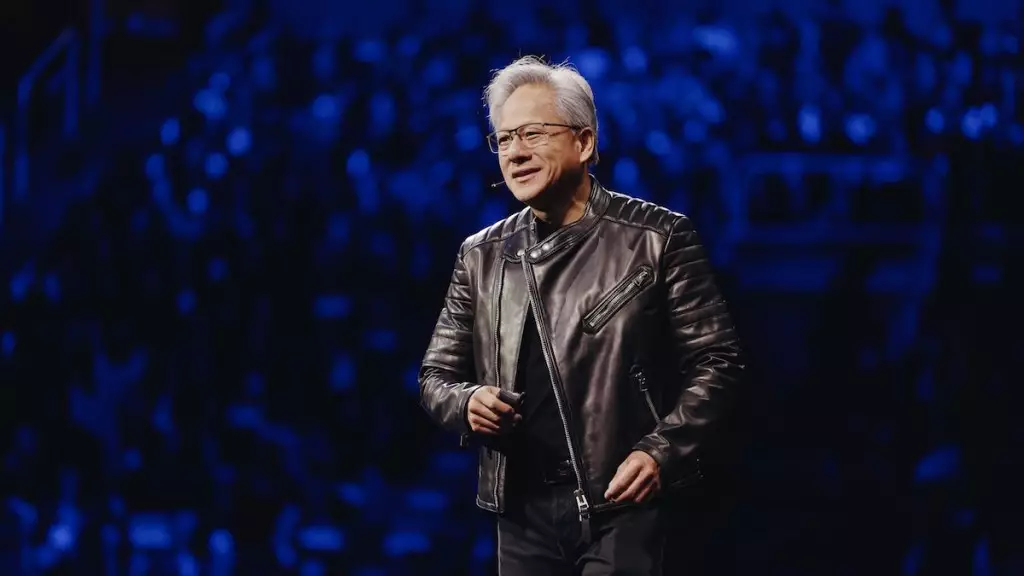As we stand on the brink of an unprecedented technological renaissance, NVIDIA is pioneering the landscape of artificial intelligence (AI) with remarkable innovations aimed at addressing the changing demands of the digital world. The insights shared by company founder Jensen Huang at the recent GTC conference lay bare the staggering transformation within AI compute infrastructures—a convergence of billion-parameter reasoning models that’s driving the shift from theoretical exploration to practical implementation. This seismic shift presents not only a technological evolution but also a profound economic opportunity estimated at $1 trillion.
In his keynote, Huang characterized modern data centers as “AI factories,” meticulously designed to process millions of user queries with unwavering efficiency. Given the explosive trajectory of AI applications, this transformation is nothing short of critical. The urgency of enhancing computational capabilities during a paradigm shift from traditional training methods to full-production inference highlights the necessity of innovative solutions.
Blackwell: The Dawn of a New Era
Leading the charge is NVIDIA’s Blackwell architecture, which has already demonstrated phenomenal success in the realm of performance enhancement. Boasting an extraordinary 40 times performance boost compared to its predecessor, Hopper, Blackwell redefines the operational efficiencies associated with AI model training and inference. The scaling capabilities of this architecture not only mark a significant leap forward but also set the stage for an ambitious roadmap that includes the imminent Blackwell Ultra, expected in the latter half of 2025. This next-generation GPU is engineered to further expand memory capacity, catering to the needs of tomorrow’s advanced AI models.
NVIDIA’s commitment to a rapid annual refresh of AI architectures epitomizes their swift response to technological demands. Such relentless innovation fosters an environment ripe for creating scalable and efficient AI solutions that are indispensable in various sectors, from logistics to health care.
Redefining AI Infrastructure with Vera Rubin and Beyond
The implications of NVIDIA’s groundbreaking innovations extend far beyond GPUs into a comprehensive overhaul of AI infrastructure as a whole. The anticipated Vera Rubin architecture, set for a 2026 release, promises to revolutionize bandwidth efficiency, a crucial factor given the increasing complexity of AI systems that often involve an extensive array of chips working in tandem. The foresight to develop an entire ecosystem—spanning AI-optimized storage and advanced networking—underlines NVIDIA’s strategy of driving efficiency in massive AI data centers, which are on the verge of profoundly altering operational dynamics across industries.
Moreover, the potential of these advancements is staggering. As Huang notes, the landscape of physical AI, with an estimated market influence of $50 trillion, offers expansive opportunities for sectors like robotics and automated manufacturing. Platforms such as NVIDIA’s Isaac and Cosmos are leading this charge, representing a nexus for revolutionizing the way industries employ AI technologies to elevate productivity and create unprecedented efficiencies.
The Future of Networking and Software Innovations
NVIDIA’s innovation doesn’t stop at hardware; significant strides have been made in networking too. The introduction of Spectrum-X and Quantum-X silicon photonics networking platforms signifies a pivotal shift in how AI factories interconnect millions of GPUs across various locations. With energy consumption reduction at the forefront, these new platforms promise to optimize operational sustainability—a necessity in an era increasingly critiqued for its environmental impact.
Additionally, the release of open-source Dynamo software showcases NVIDIA’s commitment to fostering collaboration within the AI community. By expediting multi-step reasoning, this software enhances the pace of innovation while lowering barriers to entry for smaller players and researchers. In doing so, NVIDIA positions itself as not only a leader in commercial applications but also as a champion for broader accessibility and community-driven advancement.
The Implementation of AI in Robotics
On the forefront of robotics, NVIDIA’s GR00T N1 model marks a pivotal development in fully customizable humanoid reasoning capabilities. This model embraces a dual-system approach that mimics human cognitive functions—instilling a level of adaptability and reasoning previously unseen in humanoid robots. Furthermore, through collaborations with giants like Google DeepMind, NVIDIA aims to refine the interaction of AI with the complexities of real-world physics, thereby augmenting robots’ ability to manage intricate tasks with precision.
These advances do not merely represent technological progress; they embody a revolutionary ethos aimed at fundamentally altering our interaction with machines. By harnessing the collective power of innovative AI technologies, NVIDIA is steadfastly engineering a future where intelligent systems not only co-exist with humans but flourish alongside them, driving us to rethink our paradigms of work and creativity.


Leave a Reply